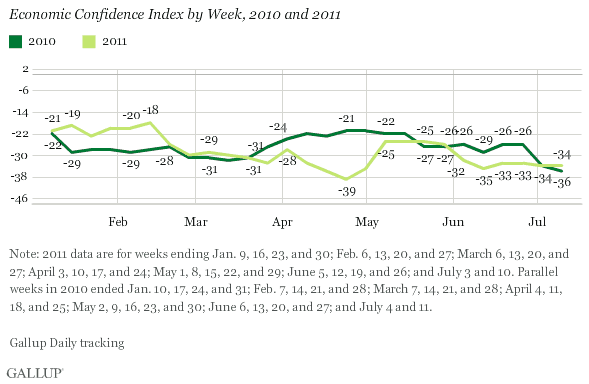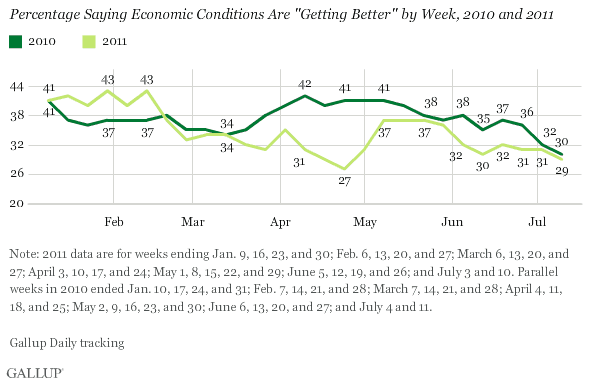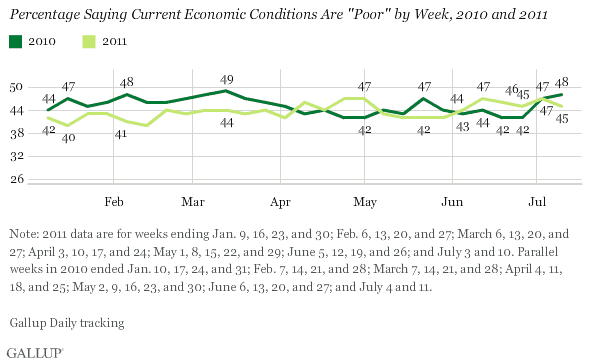PRINCETON, NJ -- Americans' economic confidence remains near its 2011 low, averaging -34 in the week ending July 10. Gallup's Economic Confidence Index has not shown any improvement in the last five weeks after a decline in early June. Last year at this time, the Index was -36, suggesting there has been no year-over-year improvement.

U.S. economic confidence was somewhat higher in the first six weeks of this year, but declined from mid-February through the end of April. Confidence improved in May -- likely in response to the news of Osama bin Laden's death in a U.S. military raid -- before dropping back near the lows for the year during June and early July.
Gallup's Economic Confidence Index combines two measures: one assessing Americans' views about whether the U.S. economy is "getting better" or "getting worse," and the second involving Americans' ratings of current economic conditions as "excellent," "good," "only fair," or "poor." Both ratings have been near their 2011 lows in June and July.
Percentage "Getting Better" Remains Low
In the week ending July 10, 29% of Americans said the U.S. economy is "getting better" -- on par with what ÆéûÜǨû§measured throughout the prior four weeks and down from 37% during most of May. The index followed essentially the same pattern in 2010, leaving almost two-thirds of Americans in both years who say the U.S. economy is getting worse.

Percentage Rating the Economy "Poor" Unchanged
Forty-five percent of Americans rated current economic conditions "poor" in the week ending July 10 -- about the same as in the previous five weeks. This roughly parallels the deteriorated situation of early July 2010.

Implications
Over the past several weeks, Americans have increasingly recognized the economic slowdown in the U.S., and Gallup's economic confidence scores show this: they are near their lows for the year. The flatness of the scores does not seem to reflect the surge on Wall Street at the end of June or the overall decline in gas prices since mid-May. By the same token, Gallup's Daily averages do not yet reflect any reaction to Friday's negative jobs report from the U.S. government.
Federal Reserve Board Chairman Ben Bernanke's testimony this week before the House and the Senate might help improve Americans' confidence in the economy. A debt ceiling agreement between the president and congressional leaders could also help improve economic perceptions.
Regardless, the current low level of economic confidence suggests something positive needs to happen if the economy is going to recover in the second half. Another decline in confidence from these levels might lead to just the opposite, creating a "soft patch" that may not be transitory.
Gallup.com reports results from these indexes in daily, weekly, and monthly averages and in Gallup.com stories. Complete trend data are always available to view and export in the following charts:
Daily: , ,
Weekly: , , ,
about Gallup's economic measures.
our economic release schedule.
Survey Methods
Results are based on telephone interviews conducted on a weekly basis in 2011 to the week ending July 10 and in 2010 to the week ending July 11. For the week ending July 10, 2011, on the ÆéûÜǨû§Daily tracking survey, interviews were conducted with a random sample of 3,005 adults, aged 18 and older, living in all 50 U.S. states and the District of Columbia.
For results based on the total sample of national adults, one can say with 95% confidence that the maximum margin of sampling error is ôÝ3 percentage points.
Interviews are conducted with respondents on landline telephones and cellular phones, with interviews conducted in Spanish for respondents who are primarily Spanish-speaking. Each sample includes a minimum quota of 400 cell phone respondents and 600 landline respondents per 1,000 national adults, with additional minimum quotas among landline respondents for gender within region. Landline telephone numbers are chosen at random among listed telephone numbers. Cell phone numbers are selected using random-digit-dial methods. Landline respondents are chosen at random within each household on the basis of which member had the most recent birthday.
Samples are weighted by gender, age, race, Hispanic ethnicity, education, region, adults in the household, and phone status (cell phone only/landline only/both, cell phone mostly, and having an unlisted landline number). Demographic weighting targets are based on the March 2010 Current Population Survey figures for the aged 18 and older non-institutionalized population living in U.S. telephone households. All reported margins of sampling error include the computed design effects for weighting and sample design.
In addition to sampling error, question wording and practical difficulties in conducting surveys can introduce error or bias into the findings of public opinion polls.
For more details on Gallup's polling methodology, visit .
